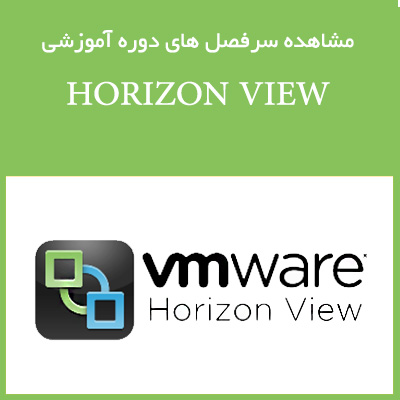مروری بر دوره
This course gives you the skills to deliver virtual desktops and applications through a single virtual desktop infrastructure platform. This course builds your skills in installing, configuring, and managing VMware Horizon® ۷ through a combination of lecture and hands-on labs. You will learn how to configure and deploy pools of virtual machines, how to manage access and security of the machines, and how to provide a customized desktop environment to end users.
آنچه می آموزید
Identify VMware Horizon components
Install and configure View Connection Server
Install and configure virtual desktops
Configure and manage VMware Horizon® Client™ systems
Configure and manage pools of physical and virtual machines
Configure and manage automated pools of full virtual machines
Configure and manage pools of linked-clone desktops
Configure and manage automated pools of instant clones
Configure and manage Remote Desktop Services (RDS) pools of desktops and applications
Use Horizon Administrator to configure the VMware Horizon environment
Configure secure access to virtual desktops
Use VMware User Environment Manager™ to manage user personalization and application configurations
Describe steps to deploy profile management
Use VMware App Volumes™ to provision and manage applications
Manage the performance and scalability of a VMware Horizon deployment
سرفصل ها
Course Introduction
Review course goals
Review course objectives
Review the course outline
Find additional resources after this course
Introduction to VMware Horizon
Recognize the features and benefits of VMware Horizon
Identify the major function of each VMware
Horizon component
Define a use case for your virtual desktop and application infrastructure
View Connection Server
Identify the VMware vSphere® requirements for a connection server
Describe the network and firewall configurations for View Connection Server
License VMware Horizon components
Configure View Connection Server
VMware Horizon Pools and Desktops
Outline the process and choices in setting up VMware Horizon 7 virtual machines
Compare the remote display protocols that are available in VMware Horizon
List the ports that must be opened in the machine’s firewall for VMware Horizon operations
Outline the configuration choices when installing Horizon Agent
Identify the steps to set up a template for desktop pool deployment
Describe how information on the Users and Groups page can be used to control and monitor View users
Explain the hierarchy of global policies, pool-level policies, and user-level policies
List the View Group Policy administrative (ADM) template files
Horizon Client Options
Describe the requirements for a Horizon Client installation
Explain USB redirection and options
Describe the power states for desktops
Define and compare a thin client with a system running Horizon Client
Discuss the benefits of Virtual Printing
Explain the Virtual Printing architecture
Describe the configuration options for Virtual Printing
Explain the location-based printing feature
Creating Automated Pools of Full Virtual Machines
Recognize how an automated pool operates
Compare dedicated-assignment and floating- assignment pools
Outline the steps to create an automated pool
Examine the entitlement of desktops in automated pools
Creating and Managing Linked-Clone Desktops
Describe the VMware linked-clone technology
Explain why both a parent virtual machine and a snapshot must be used to create linked clones
Outline the system requirements for View Composer
Describe the relationship between a persistent
disk and the system disk
Outline the steps necessary to set up an automated desktop pool that uses linked clones
Compare the purpose of the parent and the replica virtual machines
Compare the linked-clone management
operations
Describe the management operations for persistent disks
Creating and Managing Instant-Clone Pools
Identify the advantages of instant clones
Distinguish View Composer clones from instant clones
Identify the requirements of instant clones
Describe the types of instant-clone virtual machines
Explain how folders are used to delegate pool administration
Outline the steps to set up an automated pool that
uses instant clones
Describe instant-clone limitations in VMware Horizon 7
Describe the creation of instant clones
Set up an automated pool of instant clones
Creating RDS Desktop and Application Pools
Explain the difference between an RDS desktop pool and an automated pool
Describe how a user can access a single application by using the RDS application pool
Describe the relationship between an RDS host, a
farm, and an application pool
Create an RDS desktop pool and an application pool
Explain how the View Composer linked-clone technology can automate the build-out of RDS server farms
Describe the load-balancing options for RDS
hosts
VMware Horizon 7 Authentication
Compare the authentication options that View Connection Server supports
Describe the purpose of TrueSSO single sign-on
Identify TrueSSO single sign-on components
Managing VMware Horizon Security
Compare tunnels and direct connections for client access to desktops
Compare the benefits of using either VMware Horizon Security Server or Access Point in the DMZ
Identify where the tunnel endpoints are in a
security server or an Access Point implementation
Identify the tunnel endpoints when the security gateway is not used
Explain a direct connection
List the advantages of direct connections
Profile Management Using User Environment Manager
Identify the use cases and benefits of using User Environment Manager
Describe User Environment Manager and its architecture
Explain the User Environment Manager functional areas and their benefits
Explain User Environment Manager profile management and its features
Use the User Environment Manager management
console and application profiler to manage user personalization and application configurations
Using App Volumes to Provision and Manage Applications
Explain how App Volumes works
Identify the features and benefits of App Volumes
Identify the interface elements of App Volumes
Install and configure App Volumes
Command-Line Tools and Backup Options
Describe key View Connection Server features that are available as command-line options with the vdmadmin command
Explain the purpose of kiosk mode for client
systems and how it is configured
Explain why you might want to limit the domains that View Connection Server makes available to end users
Identify the log locations for each VMware
Horizon component
VMware Horizon Performance and Scalability
Describe the purpose of a replica server
Compare a replica server to a standard connection server
Explain how multiple VMware Horizon servers maintain synchronization
List several best practices for multiserver
deployment in a pod
Describe how a load-balancing capability might improve VMware Horizon performance
مخاطبان این دوره
Technical personnel who work in the IT departments of end-customer companies and people who are responsible for the delivery of remote or virtual desktop services

